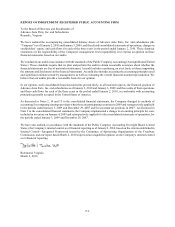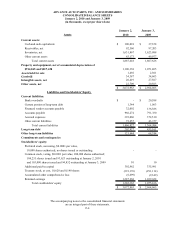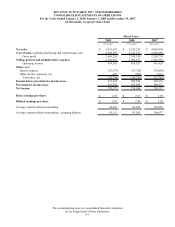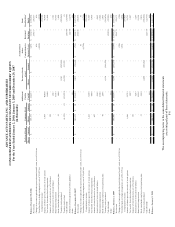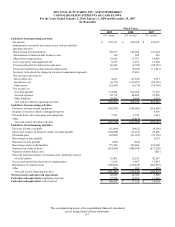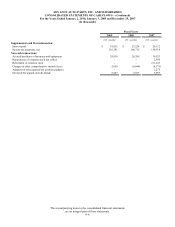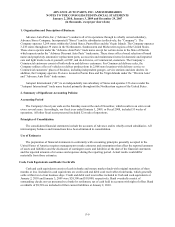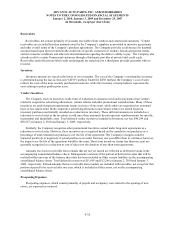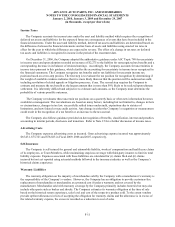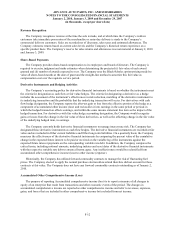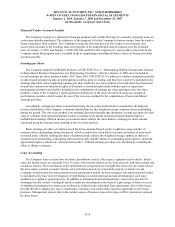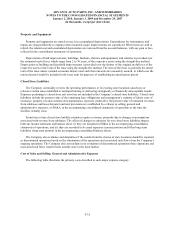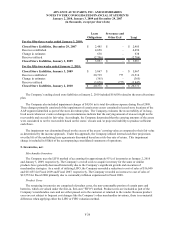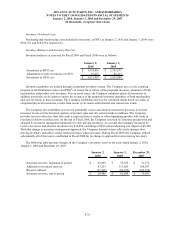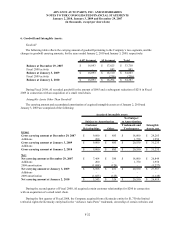Advance Auto Parts 2009 Annual Report Download - page 65
Download and view the complete annual report
Please find page 65 of the 2009 Advance Auto Parts annual report below. You can navigate through the pages in the report by either clicking on the pages listed below, or by using the keyword search tool below to find specific information within the annual report.ADVANCE AUTO PARTS, INC. AND SUBSIDIARIES
NOTES TO THE CONSOLIDATED FINANCIAL STATEMENTS
January 2, 2010, January 3, 2009 and December 29, 2007
(in thousands, except per share data)
.
F-12
Revenue Recognition
The Company recognizes revenue at the time the sale is made, and at which time the Company’s walk-in
customers take immediate possession of the merchandise or same-day delivery is made to the Company’s
commercial delivery customers. Sales are recorded net of discounts, sales taxes and estimated allowances. The
Company estimates returns based on current sales levels and the Company’s historical return experience on a
specific product basis. The Company’s reserve for sales returns and allowances was not material at January 2, 2010
and January 3, 2009.
Share-Based Payments
The Company provides share-based compensation to its employees and board of directors. The Company is
required to exercise judgment and make estimates when determining the projected (i) fair value of each award
granted and (ii) number of awards expected to vest. The Company uses the Black-Scholes option-pricing model to
value all share-based awards at the date of grant and the straight-line method to amortize this fair value as
compensation cost over the requisite service period.
Derivative Instruments and Hedging Activities
The Company’s accounting policy for derivative financial instruments is based on whether the instruments meet
the criteria for designation as cash flow or fair value hedges. The criteria for designating a derivative as a hedge
includes the assessment of the instrument’s effectiveness in risk reduction, matching of the derivative instrument to
its underlying transaction and the probability that the underlying transaction will occur. For derivatives with cash
flow hedge designation, the Company reports the after-tax gain or loss from the effective portion of the hedge as a
component of accumulated other income (loss) and reclassifies it into earnings in the same period or periods in
which the hedged transaction affects earnings, and within the same income statement line item as the impact of the
hedged transaction. For derivatives with fair value hedge accounting designation, the Company would recognize
gains or losses from the change in the fair value of these derivatives, as well as the offsetting change in the fair value
of the underlying hedged item, in earnings.
The Company currently holds derivative financial instruments to manage interest rate risk. The Company has
designated these derivative instruments as cash flow hedges. The derivative financial instruments are recorded at fair
value and are included in Other current liabilities and Other long-term liabilities. On a quarterly basis, the Company
measures the effectiveness of the derivative financial instruments by comparing the present value of the cumulative
change in the expected future interest to be paid or received on the variable leg of the instruments against the
expected future interest payments on the corresponding variable rate debt. In addition, the Company compares the
critical terms, including notional amounts, underlying indexes and reset dates of the derivative financial instruments
with the respective variable rate debt to ensure all terms agree. Any ineffectiveness would be reclassified from
accumulated other comprehensive income (loss) to other income (expense).
Historically, the Company has utilized forward commodity contracts to manage the risk of fluctuating fuel
prices. The Company elected to apply the normal purchase election allowed and therefore did not account for these
contracts at fair value. The Company does not have any forward commodity contracts outstanding as of January 2,
2010.
Accumulated Other Comprehensive Income (Loss)
The purpose of reporting Accumulated comprehensive income (loss) is to report a measure of all changes in
equity of an enterprise that result from transactions and other economic events of the period. The changes in
accumulated comprehensive income are reported as other comprehensive income and refer to revenues, expenses,
gains, and losses that are included in other comprehensive income but excluded from net income.


